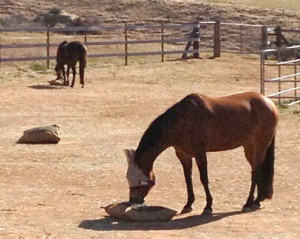NickerNews’ & BestHorsePractices’ Emily Thomas Luciano spoke with our new partner, Hay Pillow’s Monique Warren, from  her California-based operations.
her California-based operations.
What inspired you to develop this product?
MW: Hay Pillow™ Inc. was born when I had attempted several variations of homemade slow feeders over a 2 year period and finally designed one that worked. After learning the importance of slow feeding and eating from ground level I could not purchase one that slowed down my horse’s consumption rate enough.
What’s your favorite thing about being an entrepreneur?
MW: The wide variety of tasks on a daily basis and the creativity involved in marketing and developing new products. It’s exciting!
How long have you been in business?
MW: The website, www.thehaypillow.com, launched April 15 , 2013
It’s obvious that you’re a proponent of keeping your horse care as natural as possible. Is that the way you’ve always cared for your own horses, or did you have a light bulb moment?
MW: I was always open minded even though I’ve been a horse guardian for over 40 years. The biggest changes started when I had a horse that wasn’t “right” and I needed to investigate alternatives on my own, after all, I was ultimately responsible for her wellbeing. It started with transitioning my horses to barefoot which then prompted me to study diet and lifestyle extensively. I then realized that all of my horses benefited from the more natural lifestyle, not just the one that wasn’t “right.”
After reading your “About Us” page, it sounds like developing The Hay Pillow was quite a process. Tell us about a couple of the prototypes— the most disastrous, perhaps, about the light bulb moment that led you to the final model.
 I had no intentions 6 years ago of starting a business when I started making slow feeders. I had a need that wasn’t met by products available on the market. I desperately wanted my horses to eat and live together full time offering hay 24/7 without consuming more calories than necessary to maintain a healthy weight.
I had no intentions 6 years ago of starting a business when I started making slow feeders. I had a need that wasn’t met by products available on the market. I desperately wanted my horses to eat and live together full time offering hay 24/7 without consuming more calories than necessary to maintain a healthy weight.
I initially started with numerous hard-sided feeders. Some with metal grates or holes drilled in the bottom. Either the feeders fed too fast or they could not eat at all. In addition, some voracious individuals can actually wear grooves in their teeth or the enamel wears off with stiffer webbing. None of the bags, nets or feeders on the market was slow enough to allow for limited hay 24/7. The only solution was netting, this allowed a smaller size opening and enables them to eat from it, because it conformed to the hay. It also encouraged them to use their lips as well as their teeth to extract hay which is more natural and they seemed to enjoy it. The initial Hay Pillow prototypes were designed to be clipped in a tub. After trying a wide variety of closures and fabrics, I ended up with a bag that could be used on the ground.
How many states/countries/continents have you sold to?
MW: All 50 states, Canada, England, Switzerland, Netherlands, Ireland, Germany, Italy, France, Austria, Norway, Denmark, Australia, Finland, Israel, Spain, Saudi Arabia and United Kingdom. 15% of our sales are International.
MW: Breakfast, lunch, and dinner are meals consumed by humans, but are not natural for a horse. Equines are grazing herbivores with a digestive system designed for constant uptake. If your equine does not have forage available 24/7, consider implementing a slow-feeding program. This can be accomplished by using a grazing muzzle when on pasture or a slow feeder for hay. Extending meals will not produce the mental and physical health benefits of free-choice forage. Mentally and physically, horses require free-choice forage.
I appreciate the interview! Let me know if you have any questions.

